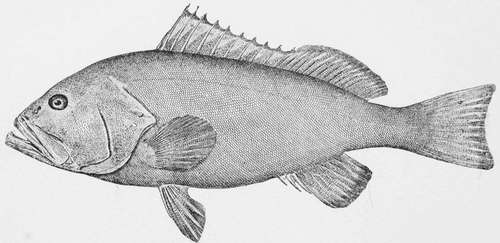The Grouper-Epinephelus Morio (Cuv. , Gill)
Description
This section is from the book "American Game Fishes", by W. A. Perry. Also available from Amazon: American Game Fishes: Their Habits, Habitat, and Peculiarities; How, When, and Where to Angle for Them.
The Grouper-Epinephelus Morio (Cuv. , Gill)
I give to this well-known and valuable food-fish of the Florida coast, the name affixed to it by scientists, as I suppose, though the synonomy of the genus is much confused, and the name, to be adopted, uncertain. The description given by Jordan and Gilbert, of E. morio, seems more like the common Grouper than any other which they describe. Holbrook, in his"Fishes of S. Carolina," describes what I take to be the same species, under the name of Serranus crythrogaster. The name Grouper is found in Roman's list of the fishes of the East Florida coast. How far north it occurs I do not know, but it is abundant and large in the West Indies, as I am informed. It is a thick-set, robust fish, of the Perch family, with hard spines in the dorsal fin; large head and mouth, with sharp teeth. Color, light olive, mottled with darker lines, like tortoise shell. Fins tipped with blue; inside of mouth red.
The Grouper is found near the bottom, in deep holes and channels, near the roots of mangrove trees, under which it makes its stronghold. It is never found far from this fortress, to which it retreats when hooked or alarmed. The bait is Mullet, either cut or whole, the latter attracting the larger specimens. In size it is taken from half a pound to fifteen pounds, seldom with the net. It is voracious, but shy and easily alarmed; and after one has escaped from the hook, or after the capture of two or three, the others seem to take fright, and will seldom take a bait in that place for some days. When hooked, it makes straight for its hole, and can only by main force be kept from it; so that only those of moderate size are taken with rod and reel-say up to five or six pounds weight. The larger ones can only be landed with a hand-line. It is a trial of strength between the man and his tackle and the fish-the latter, if of large size, often breaking loose, or gaining its hole under the roots from whence it cannot easily be dislodged, the result being the loss of tackle and patience. The rod-fisher loses more than half the Groupers he hooks. I have never been able to kill, on a rod, a Grouper over five pounds. Other rod-fishers have perhaps been more fortunate or skillful. As is well known to anglers, the first rush of a strong and heavy fish cannot safely be resisted, and the Grouper makes only one. If he would fight in open water, like the Bass, he could be tired out; but he takes all the advantage, and one seldom gets more than two or three in a day.

Red Grņuver-Epinephelus morto.
The flesh of the Grouper is rich and well-flavored, and is highly prized, perhaps partly on account of the scarcity of the fish, and difficulty of its capture. To my taste it much resembles that of the Red Bass, when in good condition.
Jordan And Gilbert's Description
Red Grouper-Epinephclus morio (Cuv., Gill), brownish, marbled with ash; Salmon-color below; soft parts of the vertical fins margined with blue. Body oval, compressed above; profile oblique, gently curved; mouth terminal, large, somewhat oblique; maxillary reaching beyond eye; e)re about as long as snout. Head 2^; depth 3. D. XI, 17; A. Ill, 9; Lat. I 106; caeca 28. Atlantic Coast, chiefly southward.
Continue to:
- prev: Sheep's-Head-Diplodus Probatocephalus (Walt. )
- Table of Contents
- next: The Mangrove Snapper-Lutjanus Aurorubens (Cuv., Gill)
